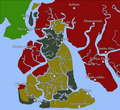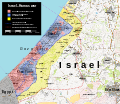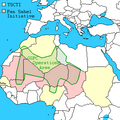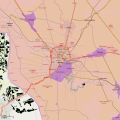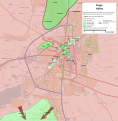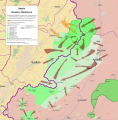|
تضامنًا مع حق الشعب الفلسطيني |
ملف:Tadmur offensive (2015).jpg
من أرابيكا، الموسوعة الحرة
اذهب إلى التنقل
اذهب إلى البحث

حجم هذه المعاينة: 800 × 405 بكسل. الأبعاد الأخرى: 320 × 162 بكسل | 640 × 324 بكسل | 1٬139 × 577 بكسل.
الملف الأصلي (1٬139 × 577 بكسل حجم الملف: 377 كيلوبايت، نوع MIME: image/jpeg)
| هذا ملف من ويكيميديا كومنز. معلومات من صفحة وصفه مبينة في الأسفل. كومنز مستودع ملفات ميديا ذو رخصة حرة. |
ملخص
| الوصفTadmur offensive (2015).jpg |
English: Tadmur (Arabic: تدمر; ancient Palmyra, Homs Governorate). Map of the territorial changes during the first 7 days of the Tadmur offensive. Since Syrian rebels and al-Nusra Front were gaining ground in the Idlib Governorate, the Syrian Government redeployed forces from the Homs Governorate to the the Idlib Governorate; however, ISIL took advantage of the troop movement to launch an offensive in the Tadmur region. On the day the offensive began, on May 13, ISIL captured 30% of the Homs Governorate's Tadmur District, advancing around 100 miles in some areas. On May 14, ISIL entered the northern part of Palmyra city, and clashes erupted until the Syrian Army expelled ISIL from the city on May 16. From May 16-18, ISIL captured the T3 Pumping Station, and captured some towns to the west of Palmyra, while putting other neighboring towns to the north-northwest of Palmyra under siege. However, on May 20, ISIL captured Tadmur, the ruins of Palmyra, the town of Ameriya, and the surrounding towns to the north and the east. During the next 6 days, ISIL advanced even further westward, solidifying their control of the region around Palmyra, and capturing a stretch of land to the south of Qaryatayn. On May 20, ISIL broke through Syrian Army lines and attacked the Tiyas T4 Airbase, until Syrian Army forces repelled the attack 4 days later. ISIL also managed to advance southward from their territory to the east of Homs, capturing the city of Furqlus on May 22. On May 26, the Syrian Army sent reinforcements to the region, stemming the ISIL advance, and pushing towards the frontline to the north and the south of Palmyra.
|
||||
| التاريخ | |||||
| المصدر | عمل شخصي | ||||
| المؤلف | BlueHypercane761 | ||||
| إصدارات أخرى |
|
ترخيص
أنا، صاحب حقوق التأليف والنشر لهذا العمل، أنشر هذا العمل تحت الرخصة التالية:
هذا الملفُّ مُرخَّصٌ برخصة المشاع الإبداعي الدَّوليَّة المُلزِمة بنسب العمل إلى مُؤَلِّفه وبترخيص المُشتقَّات بالمثل 4.0.
- يحقُّ لك:
- مشاركة العمل – نسخ العمل وتوزيعه وبثُّه
- إعادة إنتاج العمل – تعديل العمل
- حسب الشروط التالية:
- نسب العمل إلى مُؤَلِّفه – يلزم نسب العمل إلى مُؤَلِّفه بشكل مناسب وتوفير رابط للرخصة وتحديد ما إذا أجريت تغييرات. بالإمكان القيام بذلك بأية طريقة معقولة، ولكن ليس بأية طريقة تشير إلى أن المرخِّص يوافقك على الاستعمال.
- الإلزام بترخيص المُشتقات بالمثل – إذا أعدت إنتاج المواد أو غيرت فيها، فيلزم أن تنشر مساهماتك المُشتقَّة عن الأصل تحت ترخيص الأصل نفسه أو تحت ترخيص مُتوافِقٍ معه.
الشروحات
أضف شرحاً من سطر واحد لما يُمثِّله هذا الملف
العناصر المصورة في هذا الملف
يُصوِّر
قيمة ما بدون عنصر ويكي بيانات
١٨ مايو 2015
تاريخ الملف
اضغط على زمن/تاريخ لرؤية الملف كما بدا في هذا الزمن.
| زمن/تاريخ | صورة مصغرة | الأبعاد | مستخدم | تعليق | |
|---|---|---|---|---|---|
| حالي | 07:18، 17 يونيو 2015 |  | 1٬139 × 577 (377 كيلوبايت) | commonswiki>BlueHypercane761 | Updated the map to show the remaining offensive actions taken by both sides. |
استخدام الملف
ال1 ملف التالي مكررات لهذا الملف (المزيد من التفاصيل):
- ملف:Tadmur offensive (2015).jpg من ويكيميديا كومنز
الصفحة التالية تستخدم هذا الملف:

